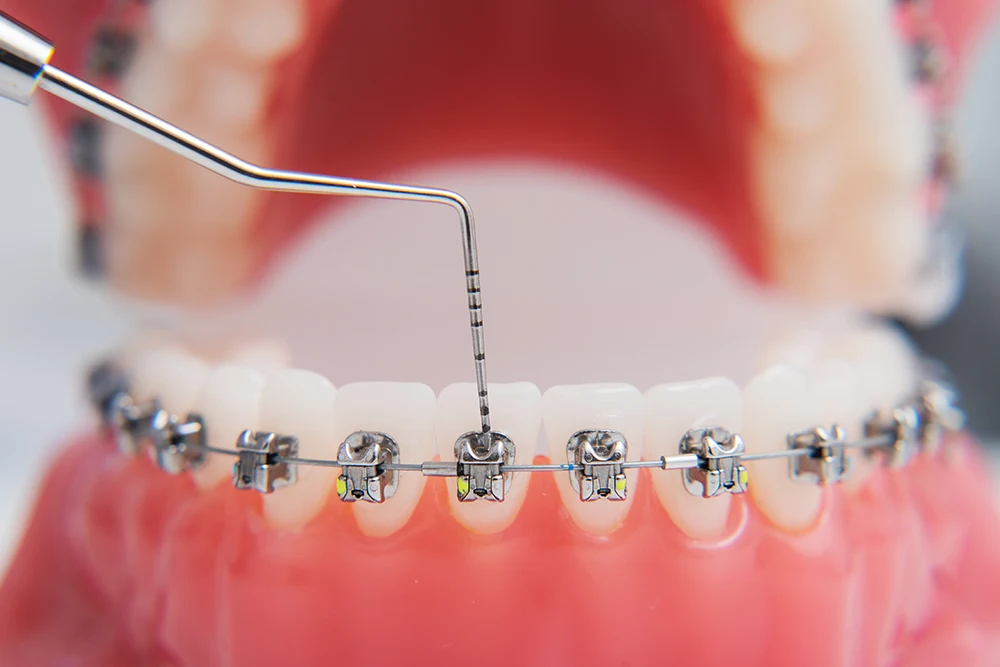Key Takeaways
- Braces tightening helps apply fresh pressure on your teeth to keep them moving toward proper alignment.
- It’s normal to feel soreness or discomfort for a few days after each session.
- Regular tightening sessions are needed every 4 to 6 weeks to avoid delays in treatment.
- Eating soft foods and using simple home remedies like cold water or salt rinses can ease the pain.
- Skipping appointments can slow progress and lead to longer treatment times.
If you’ve got braces or are planning to get them, you’ve probably heard about tightening appointments. They might sound a bit scary at first, but they play a major role in how braces actually work. These regular visits help shift your teeth into place and keep your treatment on track. In this guide, we’ll walk you through why tightening matters, how it’s done, how often it happens, and what you can expect during and after each session.
What is Braces Tightening?
Braces tightening is when your orthodontist adjusts your braces to keep your teeth moving in the right direction. This usually happens every 4 to 6 weeks. During the visit, they might change the wire or replace the rubber bands to apply fresh pressure. This pressure is what helps guide your teeth into place. You might feel a bit sore or sensitive afterward, but that’s normal and part of the process. These regular adjustments are what slowly shape your smile over time.
Want to know more about the different types of braces and how they work? Explore our complete guide to braces.
Why Do Braces Need to Be Tightened?
Braces need to be tightened because your teeth won’t shift on their own. They need steady pressure to keep moving toward their ideal alignment. Here’s why the tightening process matters:
-
Keeps the Pressure Consistent
As your teeth shift, the pressure from your current wires or bands starts to lessen. Tightening restores that pressure so your teeth keep moving.
-
Adjusts for Your Progress
Every time you visit your orthodontist, they check how your teeth have moved and make new adjustments based on that. Tightening helps make sure the treatment keeps moving in the right direction.
-
Corrects New Alignment Needs
As some teeth move, others might need extra attention. Tightening allows your orthodontist to target specific areas that may need a bit more pressure.
-
Speeds Up the Process
Without regular tightening, your braces won’t work efficiently. Staying on schedule helps you finish treatment sooner and avoid delays.
-
Prevents Stalling
If braces aren’t tightened, your teeth can settle into their current position. This can stall progress and extend how long you’ll need to wear braces.
How Are Braces Tightened?
Here’s how the process usually goes when you visit to get your braces tightened:
-
Step 1: Removing the Old Bands
First, the orthodontic assistant will remove the small rubber bands that are holding the main wire in place. These bands are called ligatures. Taking them off doesn’t hurt at all. Think of it like gently slipping off a hair tie. It’s quick and easy.
-
Step 2: Checking Your Progress
Next, your orthodontist will take a close look at how your teeth have shifted since your last appointment. They might look at old photos, scans, or just examine your teeth visually. This step helps them decide what kind of adjustments are needed to keep things moving in the right direction.
-
Step 3: Adjusting or Replacing the Wire
This is the main part of the tightening session. Depending on how your teeth are progressing, your orthodontist might do one of the following:
- Keep the same wire but adjust it slightly to create more pressure.
- Replace it with a new wire that’s a bit stronger or thicker to apply more force.
- Add springs, spacers, or rubber bands to target specific areas that need more attention.
You might feel a bit of tightness or pressure during this step. That’s normal. It just means the wire is doing its job and helping your teeth move into place. Most people describe it more as a snug feeling than actual pain.
-
Step 4: Putting On New Bands
Once the wire is secured, new rubber bands are placed to hold it in position. This is your chance to pick new colors if you want. Many kids (and even adults) look forward to this part. It’s a small way to make the whole experience more fun and personal.
-
Step 5: Final Check Before You Leave
Lastly, your orthodontist will do a final check to make sure everything is sitting right and feels okay. If something feels too tight or pokes your cheek, this is the time to mention it. Once everything looks and feels good, you’re ready to go.
How Often are Braces Tightened?
The average frequency is 4-6 weeks. But your orthodontist is the best person to tell you when you need braces tightening. They might call you sooner or later, depending on your case. But sometimes, you might need braces tightening before your scheduled appointment. Contact your orthodontist at the earliest if you feel that your braces are losing grip early. Not feeling any pressure from braces while eating is also a warning sign.
Does Getting Braces Tightened Hurt?
Yes, it usually does. After your braces get tightened, you’ll likely feel some soreness or mild pain for a day or two. This happens because the wires are putting more pressure on your teeth to move them into the right spot. It’s a normal part of the process, and while it might be uncomfortable, it means your braces are doing their job. Each tightening brings you one step closer to a straighter smile.
How Long Do Braces Hurt After Tightening?
The pain or soreness usually lasts for about 2 to 3 days. For some people, it might ease up in a day. For others, it could take a bit longer. The first 24 hours are often the most uncomfortable, especially while chewing. After that, your teeth begin adjusting to the new pressure and the pain slowly fades. If the pain feels too intense or continues beyond a week, it’s a good idea to check with your orthodontist.
How to Stop Braces Pain After Tightening?
Here are a few simple things you can do to feel better:
Take an Oral Anaesthetic
A topical oral gel like Orajel or a mild over-the-counter pain reliever can help numb the gums and ease discomfort. Just apply a small amount to the sore spots using a cotton swab or your finger.
Eat Soft Food
Eat soft and mushy food for 1-2 days after your braces adjustment. Avoid hard foods. You can take more liquids like yogurts and soups.
Take OTC Pain Relievers
You can take over-the-counter pain relievers to get temporary relief. But don’t use them often. And take them only when the pain is unbearable.
Use an Ice Pack
Wrap an ice pack in a clean cloth and press it gently against your cheek where it hurts. The cold helps reduce inflammation and dulls the pain. You can do this for 10 to 15 minutes at a time.
Drink Cold Water
Sipping cold water throughout the day can give you some relief. It helps numb the soreness and soothes the irritated tissues around your teeth.
Go Easy on Brushing & Flossing
Brush and floss with the proper technique when you are on braces. Pressing or pushing your teeth hard might aggravate your braces tightening pain.
Chew & Massage
An increased blood flow can get you major relief from pain and soreness. So chew your food correctly and massage your gums and jaw with your fingers to increase blood flow.
Apply Dental Wax
Your orthodontist can suggest some good dental or orthodontic wax. This wax protects your inner cheeks and gums from the rough surface of newly adjusted brackets and wires.
Try a Warm Salt Water Rinse
Mix a teaspoon of salt in a glass of warm water and swish it gently around your mouth. This helps ease pain and keeps the area clean, which is especially useful if your gums feel swollen or irritated.
Be Patient
Sometimes, the best thing to do is just give it time. Your mouth is adjusting to the pressure, and the discomfort will pass soon. Stick to soft foods, avoid chewing gum or anything hard, and let your mouth rest while your braces do the work.
What is the Best Food After Braces are Tightened?
When your braces have just been tightened, it’s normal to feel a bit of soreness in your teeth and jaw. That discomfort can make chewing harder than usual, so it’s a good idea to be careful with what you eat during this time. The best thing you can do is stick to soft foods that are gentle on your mouth and easy to swallow. These foods won’t put pressure on your teeth and will help you stay comfortable as the soreness fades.
Here are some soft foods that usually feel soothing after a tightening:
- Bananas
- Eggs
- Mashed potatoes
- Noodles
- Oatmeal
- Rice
- Smoothies
- Soups
- Tortillas
- Yogurt
While it’s helpful to know what to eat, it’s just as important to know what to avoid. Right after your braces are tightened, hard and chewy foods can make the soreness worse and may even damage your braces. Some foods might feel harmless, but they can add unnecessary pressure on your teeth or get stuck in your brackets.
Try to avoid the following:
- Chewy candies
- Chips
- Granola
- Hard fruits and vegetables like apples and carrots
- Nuts
- Tough or hard meats
Being mindful of your food choices right after a tightening can make a big difference. It helps ease the pain, protects your braces, and keeps your treatment on track.
What Happens If You Don’t Get Your Braces Tightened?
There is no danger to your dental health or harmful side effects if you don’t get your braces tightened. But as we stated earlier, braces lose their grip on your teeth when your teeth move because of the gradual pressure. Thus, braces will remain ineffective till the time they are tightened or adjusted. This will increase your treatment duration.
What are the Side Effects of Braces Tightening?
Getting your braces tightened is a normal part of the process, but it can come with a few short-term side effects like:
-
Soreness and Tenderness:
This is the most common thing you’ll feel after a tightening session. Your teeth might feel a bit sore or sensitive for a day or two as they start to shift into their new position.
-
Difficulty Chewing:
Eating can be uncomfortable for a few days. That’s why it’s a good idea to switch to soft foods like mashed potatoes, smoothies, or soups until the soreness fades.
-
Irritation:
The newly adjusted wires and brackets might rub against your cheeks, lips, or tongue. It can feel a bit annoying at first, but your mouth will get used to it soon. You can also use orthodontic wax to ease the discomfort.
How Long Can You Go Without Tightening Your Braces?
It’s important not to miss your tightening appointments. If you skip them, your treatment might take longer than expected. Most orthodontists recommend getting your braces adjusted every 6 to 8 weeks. Going beyond that can slow down tooth movement and may even cause your teeth to shift in the wrong direction. To keep your treatment on track, make sure you stick to your scheduled visits.
Closing Thoughts
If you’re going through your braces journey or thinking about starting one, having the right orthodontist can make all the difference. At Thurman Orthodontics in Fresno, CA, you’ll get the care and support you need every step of the way. Whether it’s your first tightening or your final check-up, our team is ready to help you feel comfortable and confident. Visit us at 6789 N Willow Ave, Suite 106, Fresno, CA, and let your smile get the attention it deserves.
Have more questions about braces tightening or the treatment process?
FAQs
-
Is it normal for my teeth to feel loose after tightening?
Yes, it’s completely normal. After your braces are tightened, your teeth might feel a little loose for a few days. This just means the braces are doing their job and your teeth are slowly shifting into the right place.
-
Can I still play sports or an instrument after my braces are tightened?
Definitely. If you play a contact sport, make sure you wear a mouthguard to protect your mouth and braces. If you play an instrument, you might need a short adjustment period, but you can continue playing without any long-term issues.
-
Why does my orthodontist use different colored bands?
Those colored bands are called ligatures. They hold the wire to your brackets and come in different colors purely for style. You can pick your favorite colors and make your braces feel a little more like your own.
-
Will the braces tightening process affect my speech?
Usually, tightening doesn’t cause major changes to your speech. But if it’s your first time getting braces or you’ve had a big adjustment, you might notice a few small changes at first. These usually go away as your mouth gets used to the new pressure.
-
Can I eat normally after braces tightening?
You can eat, but it’s best to stick to soft foods for a day or two. Your teeth might be sore, and softer meals can help avoid extra pressure or pain.
-
How can I ease pain from braces tightening?
Try over-the-counter pain relievers, cold compresses, or warm salt water rinses. Orthodontic wax can help with irritation from brackets, and soft foods like soup or mashed potatoes can give your mouth a break.
-
How should I sleep after braces tightening?
Try to sleep on your back and use an extra pillow to keep your head supported. If your mouth feels sore, taking a pain reliever before bed can help you rest better.
-
Can I brush my teeth right after braces tightening?
Yes, you should keep up your brushing and flossing routine. Just be a bit more gentle, especially around areas that feel sore or sensitive.
-
Will my braces tightening take longer if I miss appointments?
Yes, it can. Delaying or missing your tightening sessions can slow down the movement of your teeth and make your treatment take longer overall.
-
Is there a difference between tightening and replacing the wire?
Yes. Tightening means adjusting the wire that’s already there. Replacing the wire usually means switching to a new one that’s stronger or thicker to keep the treatment moving forward. Both are part of your regular check-ups.
-
Can I drink cold drinks after braces tightening?
You can, but keep in mind that cold drinks might make your teeth feel more sensitive right after an adjustment. If that happens, try drinking water at room temperature for a day or two.
-
Can I request less tightening to avoid pain?
It’s important to trust your orthodontist’s plan. They adjust your braces based on what your teeth need. If the discomfort is bothering you, talk to them about ways to manage the pain instead of changing the treatment itself.

Dr. Brian Thurman has spent his entire life enjoying all the beauty that California has to offer. A Fresno native, he still escapes to the ocean or the mountains whenever his busy schedule allows. Driven by his love for natural beauty, Dr. Thurman enjoys creating beautiful smiles and healthy bites that last a lifetime. He is proud to be the only Ivy League trained Orthodontist in the Fresno/Clovis area.

